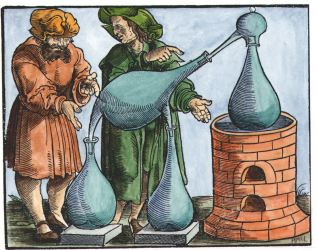| Author | Post |
|---|
adammclean
Member

| Joined: | Fri Sep 14th, 2007 |
| Location: | United Kingdom |
| Posts: | 606 |
| Status: |
Offline
|
|
Posted: Mon Sep 17th, 2007 02:19 pm |
|
I recently found a scan of an engraving which is based on the Rosarium philosophorum. From stylistic factors it would appear to be 18th century. I have lost the reference to the book from which it was taken.
Can anyone help identify this for me ?
Attached Image (viewed 1360 times):
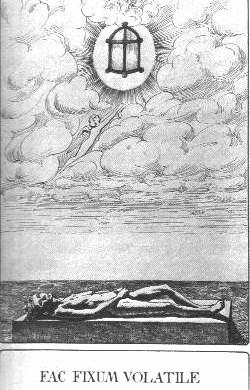
|
Neil J Mann
Member
| Joined: | Thu Feb 14th, 2008 |
| Location: | |
| Posts: | 15 |
| Status: |
Offline
|
|
Posted: Fri Feb 15th, 2008 12:43 pm |
|
It's referred to as a design from a sketch by Henri de Linthaut/Lintaut from l'Aurore et l'Ami de l'Aurore, 17C MS, bibliothèque de l'Arsenal, 3020.
I have it in Paola Lucarelli's Italian edition of Canseliet's Deux Logis Alchimiques (Edizioni Mediteranee, 1998), and it also appears on this website:
http://hdelboy.club.fr/cosmopolite_0.html Last edited on Fri Feb 15th, 2008 12:45 pm by Neil J Mann
|
J.Yves Artero
Guest
| Joined: | |
| Location: | |
| Posts: | |
| Status: |
Offline
|
|
Posted: Sat Feb 16th, 2008 08:09 am |
|
This book (L'aurore, or Dawn) was published in French in recent years:
http://www.chapitre.com/CHAPITRE/fr/BOOK/lintaut-henri-de/oeuvre-chymique,1466865.aspx
|
adammclean
Member

| Joined: | Fri Sep 14th, 2007 |
| Location: | United Kingdom |
| Posts: | 606 |
| Status: |
Offline
|
|
Posted: Sun Feb 17th, 2008 12:52 pm |
|
Neil J Mann wrote: It's referred to as a design from a sketch by Henri de Linthaut/Lintaut from l'Aurore et l'Ami de l'Aurore, 17C MS, bibliothèque de l'Arsenal, 3020.
Thanks. It looks like an 18th century engraving. I will check the original printed book of 1610 which is in the University Library here in Glasgow and see if it contains any woodcuts or engravings.
|
adammclean
Member

| Joined: | Fri Sep 14th, 2007 |
| Location: | United Kingdom |
| Posts: | 606 |
| Status: |
Offline
|
|
Posted: Sun Feb 17th, 2008 12:59 pm |
|
J.Yves Artero wrote: This book (L'aurore, or Dawn) was published in French in recent years:
Yes I have that book. The image was redrawn in pen by the editor of that book, Bernard Biebel.
Attached Image (viewed 1162 times):
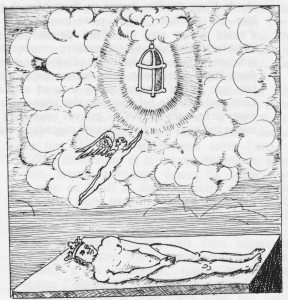
|
adammclean
Member

| Joined: | Fri Sep 14th, 2007 |
| Location: | United Kingdom |
| Posts: | 606 |
| Status: |
Offline
|
|
Posted: Sun Feb 17th, 2008 01:25 pm |
|
I note in the Biebel edition, that he gives an explanation of the figure.
" A crowned king is lying on a mortuary slab, while above him a small winged angel flies off toward a lantern.
The king is the body or subject of the art, from which the soul (or spirit) rises towards the fire represented by the lantern.
The alum, (of the Latin alumen) is a double sulphate, a salt (sel de mer) comes closer to (sacred wood)."
He then goes on to quote the well known description of the Philosophical Dragon from the book Azoth, 1610, often ascribed to Basil Valentine.
"I am old weak and sick, my nickname is Dragon. For this reason, I am confined in a pit, in order that I be enriched with a royal crown and enrich my family, now appearing in the first moment as a fugitive servant: but then, truly we will possess all the treasures of the kingdom."
Attached Image (viewed 1341 times):
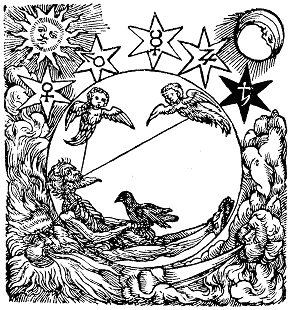 Last edited on Sun Feb 17th, 2008 01:29 pm by adammclean
|
adammclean
Member

| Joined: | Fri Sep 14th, 2007 |
| Location: | United Kingdom |
| Posts: | 606 |
| Status: |
Offline
|
|
Posted: Sun Feb 17th, 2008 01:32 pm |
|
Although Biebel associates the Linthaut image with the Azoth, I wonder if it might more correctly be linked to the Rosarium Philosophorum woodcuts
Attached Image (viewed 1009 times):

|
J.Yves Artero
Guest
| Joined: | |
| Location: | |
| Posts: | |
| Status: |
Offline
|
|
Posted: Sun Feb 17th, 2008 10:17 pm |
|
Actually the French publication is presently on ebay sale:
http://cgi.ebay.fr/ws/eBayISAPI.dll?ViewItem&item=300199720833&ssPageName=ADME:B:SS:FR:1123
Jean
|
Neil J Mann
Member
| Joined: | Thu Feb 14th, 2008 |
| Location: | |
| Posts: | 15 |
| Status: |
Offline
|
|
Posted: Mon Feb 18th, 2008 11:53 am |
|
I think it is a redrawing by Canseliet himself -- the initials in the lower right hand corner, which I hadn't given any attention before, seem to be "?C / 1924". The first letter is unclear so it could also be Julien Champagne who died in 1932, though it doesn't correspond with the signature of his drawings in Les Demeures Philosophales where he gives the whole surname. (I haven't had time to search through this very full site on the artist: http://www.archerjulienchampagne.com/ )
I agree with the closer kinship to Rosarium Philosophorum, a link which is also made on the hdelboy site ( http://hdelboy.club.fr/symb_dir_prim.html ).
Attached Image (viewed 1069 times):
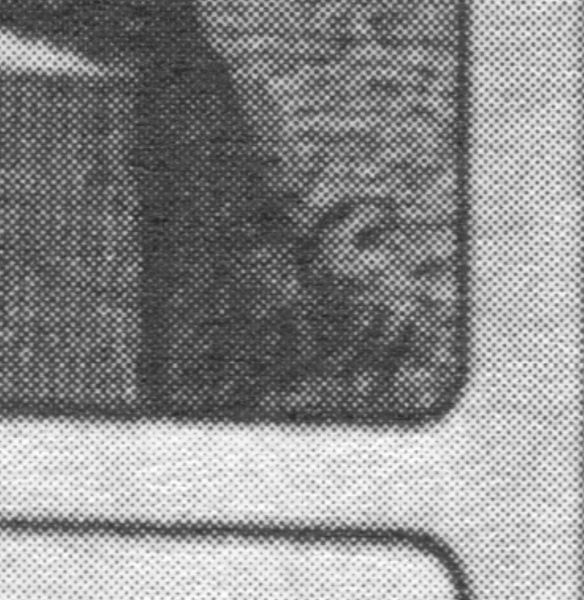 Last edited on Mon Feb 18th, 2008 12:49 pm by Neil J Mann
|
adammclean
Member

| Joined: | Fri Sep 14th, 2007 |
| Location: | United Kingdom |
| Posts: | 606 |
| Status: |
Offline
|
|
Posted: Mon Feb 18th, 2008 12:23 pm |
|
| Yes, your are right, this is indeed a drawing and not an 18th century engraving as I had thought. I can clearly see the date "1924", and the initials certainly could be read as "J.C.".
|
J.Yves Artero
Guest
| Joined: | |
| Location: | |
| Posts: | |
| Status: |
Offline
|
|
Posted: Tue Feb 19th, 2008 04:31 pm |
|
They could be read as J.C. or E.C. In fact Canseliet quotes Linthaut at least two times, once in his book Deux Logis (Two Dwellings) and once in his work entitled Alchimie, études diverses (Alchemy, various studies).
In each of these publications, one drawing after Linthaut is to be found. The one mentionned above is in the Deux Logis.
The other one is of course is in the other book, without any signature, it seems. In my copy I am inclined to read "E.C. 1924."
As well as Julien Champagne, Eugène Canseliet was an alchemist and also an expert in sketching and painting.
Both authors alternatively signed their works E.C. or J.C. and E. Canseliet or J. Champagne.
In his Deux Logis Canseliet writes that Linthaut's work is mostly valuable for its drawings.
The reference he gives is L'Aurore et l'Ami de L'aurore (Dawn and Dawn's Friend), manuscript of the Arsenal library in Paris, N° 3020 (XVIIth century).
In at least one of the editions of the Deux Logis, Canseliet adds he once copied Linthaut's works, and that this copy included the drawings.
|
Neil J Mann
Member
| Joined: | Thu Feb 14th, 2008 |
| Location: | |
| Posts: | 15 |
| Status: |
Offline
|
|
Posted: Wed Feb 20th, 2008 11:39 am |
|
Looking at the full signatures they used, that of Canseliet himself (taken from a portrait he painted of Champagne) looks more similar to the initials in the drawing than that of Champagne (taken from one of his illustrations).
Attached Image (viewed 931 times):
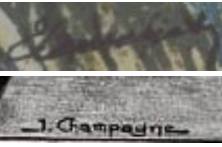
|

Current time is 09:38 am | |
|
